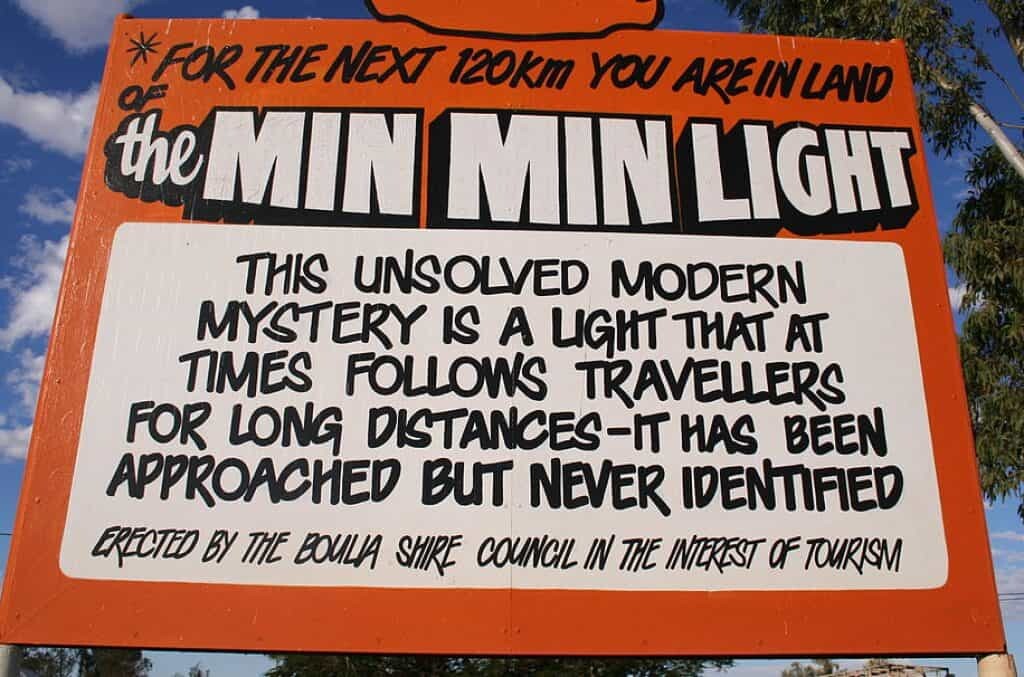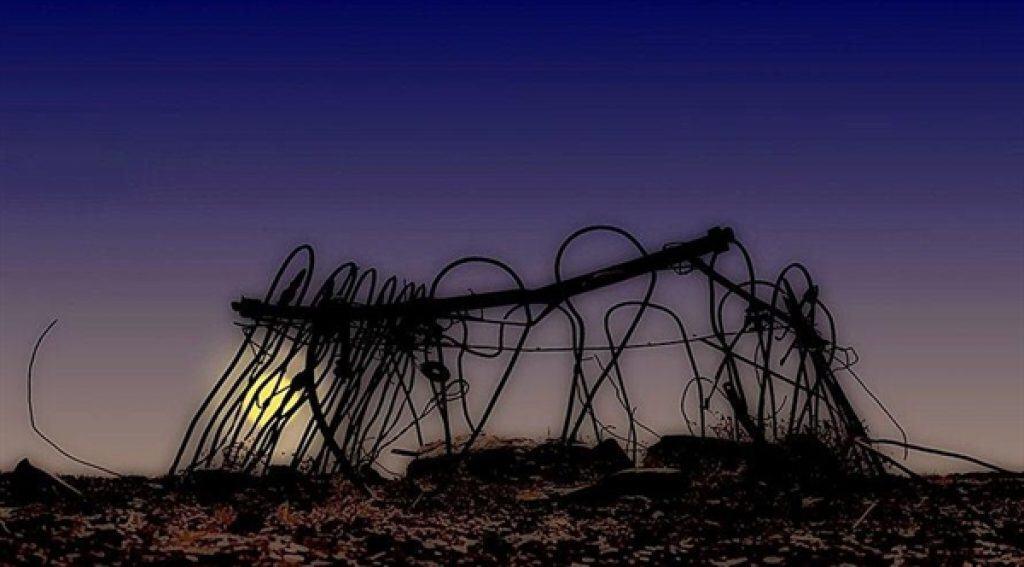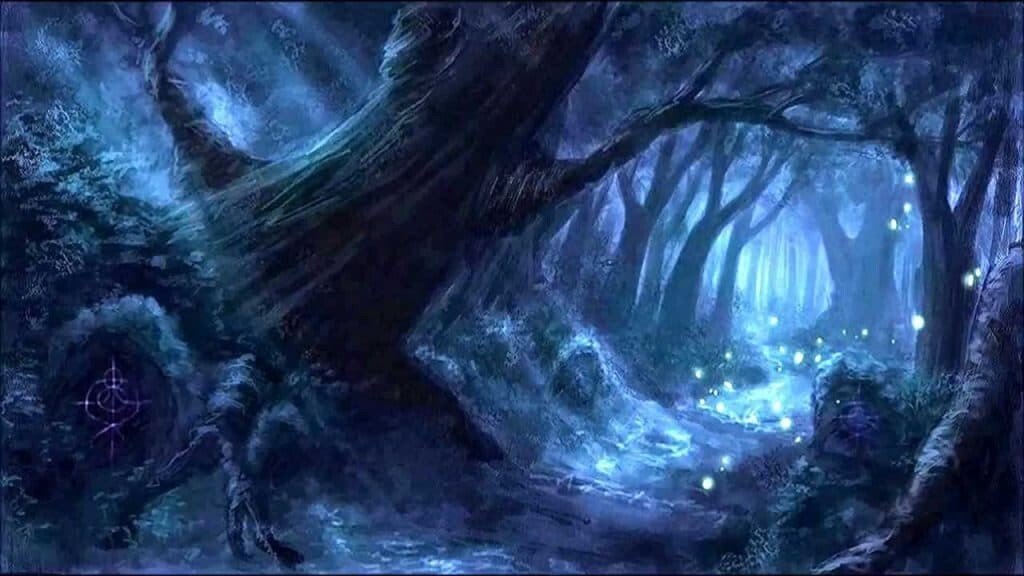In the Outback of Queensland, Australia, ghostly orbs have been frightening people for more than a century. The locals call them Min Min lights, named after the former settlement and hotel in Boulia. Sometimes the balls of light are fleeting. At other times, they seem to chase travelers and appear intelligent. Indigenous cosmological traditions mention such lights that come from the stars. Studies and other theories suggest these are no more than atmospheric anomalies or optical illusions. However, this strange phenomenon still continues to mystify witnesses.
[blockquote align=”none” author=”Bill Beatty”]Known locally as the ‘ghost light,’ it is a moon of light suspended in space, darting hither and thither, vanishing ghost-like in the dark recesses of the trees.[/blockquote]

Europeans first documented the Min Min lights in 1838. Witnesses have described them as fuzzy disks or glowing football-shaped orbs that can grow in size, get brighter or dimmer, take on colors of red, orange, blue, or green, and move around. They hover about three feet above the ground and are often mistaken for the lights of oncoming vehicles. However, unlike vehicle lights, the phantom lights in Boulia often appear to follow or approach travelers on foot, on horseback, or in a car. Sometimes the ghost lights remain still in one spot. At other times they bob up and down as if they’re dancing. Thousands of people have seen them throughout the years and described the incident as “frightening” or “spooky.”
The Stockman’s Account
On January 25, 1947, the Sydney Morning Herald published a fascinating story of an eyewitness account that had taken place earlier that century. The article began with the history of the Min Min Hotel. It was once a shady stopover that was notorious for selling drugs and tampering with the alcohol served to the area’s workmen. Some of the men stayed at the hotel, while others only passed through. Numerous men died there due to drugs, tainted alcohol, or deadly brawls. On occasion, hoodlums murdered others for money. The hotel interred the dead men in a graveyard behind the hotel.
In the early 1900s, a fire burned the hotel down. The only thing that remained was the graveyard. A short time after the fire, a stockman on horseback passed through and encountered the ghost light. He rode to the police station and made the following report:
[blockquote align=”none” author=””]I saw a strange glow appear right in the middle of the cemetery. I looked at it amazed. The glow got bigger, till it was about the size of a water-melon. I couldn’t believe my eyes as I saw it hovering over the ground. And then I broke into a cold sweat, for it started to come towards me.[/blockquote]

The stockman continued to tell the sergeant that he tried to ride away, but the light kept following him until he got to the edge of the town. The officer just smiled unbelievingly at his story. However, since the stockman’s encounter, thousands more have witnessed the lights.
Tradition and Folklore of “Ghost Lights”
It is unclear when the oral traditions of indigenous Australians began referencing eerie lights. Mavis Malbunka, an elder in the Arrernte group from Central Australia, associates their cosmological traditions with the phenomenon and also told of her own encounter in an ABC video that has since been archived. For the Arrernte, the Morning Star and the Evening Star are the father and mother of a child that fell to earth from the Milky Way. The mother in search of her child comes to earth in the form of the “big lights,” or the Min Min lights. Mavis said she and her husband were chased by the bright light. They knew that it was the mother from the “Dreamtime” (period of the creation of life). When they saw the light ascend toward the heavens, they believed the mother thought she had found her child.
According to some stories, the lights existed before European settlement on the island, but they increased when indigenous Australians began dying during fatal conflicts with Europeans. The lights, the people said, were vengeful spirits that could not rest because they needed justice for their murders. For the indigenous people, such spirits were frightening and could take a human’s life.
It wasn’t until the 21st century before science chimed in with a viable explanation.
Professor Jack Pettigrew’s Studies
Jack Pettigrew (1943-2019) was Emeritus Professor of Physiology and Director of the Vision, Touch and Hearing Research Centre at the University of Queensland. While he was studying a nocturnal bird, he had an experience with the ghost lights. During his first encounter, Pettigrew initially assumed it was the planet, Venus. However, the professor observed that the light approached the horizon but never set below it like a planet would as the earth rotated.
Related: The Norwegian Spiral: Crazy Theories in the Bizarre Mystery
On another occasion, Professor Pettigrew was driving at night with some colleagues when they saw the mysterious phenomenon. At first, they thought the lights were the shining eyes of a cat about 50 meters away. When they stopped the car, though, the lights continued to hover in front of them. The mystery only deepened when the scientists tried to track the lights to their source, which they calculated to be over 300 kilometers away, beyond the horizon.
Professor Pettigrew conducted an experiment in which he duplicated the phantom light phenomenon. He chose a night with the right weather conditions and drove about 10 kilometers away. Although he was beyond their view, six witnesses saw the car lights floating above the horizon. Many other people saw an even more spectacular illusion the following morning when they witnessed a whole mountain range floating above the ground. In 2003, Pettigrew published his findings in his paper, “The Min Min light and the Fata Morgana: An optical account of a mysterious Australian phenomenon.”
Are the Min Min Lights a Fata Morgana?
Professor Pettigrew hypothesized that the Min Min lights are a type of mirage — a Fata Morgana. This optical illusion sometimes occurs when a warm layer of air traps a layer of dense cold air underneath it. Then when light passes through the two layers, the light bends or refracts. Since it is optically tricky for humans to identify bent light, it’s easy for someone to believe that the image they see is a ghost or spirit orb. In a Fata Morgana, the image floats above the horizon or directly in front of the observer. This phenomenon is what causes the phantom ship encounter, which can be frightening for many people.
[blockquote align=”none” author=”Jack Pettigrew”]Wonderful during the day, such Fata Morgana can be terrifying at night when a single light source gives no hint that it is actually part of a mirage emanating from a great distance. Even hardened Outback observers can break down when they are unable to interpret the unusual optical properties of the light in terms of their own, very different, past experiences.[/blockquote]
Related: Solving the Ball Lightning Mystery
Ghostly Lights Around the World
Phenomena of phantom lights aren’t unique to Australia. Many other countries have folklore about ghost lights, fairy lights, will-o’-the-wisp, or ignis fatuus. Will-o’-the-wisps are mysterious lights that Celtic peoples of Ireland, Scotland, England, Wales observed. Unlike the Min Min lights, the will-o’-wisps appear mostly around wet grounds such as bogs and swamps. Some people think they are fairies or spirits. Interestingly, the jack-o’-lantern story resulted from the will-o’-the-wisp because the lights resemble a lantern moving by itself through the darkness.

In Mexico, there is a type of light similar to the ghost orbs of Boulia that locals believe are the souls of witches. They call these brujas. In the South American countries of Argentina and Uruguay, the ghost lights are luz mala meaning evil light. Luz mala is a rural phenomenon, similar to the Australian lights. However, the residents dread them and have incorporated them into many myths.
Proponents of natural theories suggest that the phantom lights result from gaseous releases from the earth — such as those often seen at graveyards — or glowing insects like fireflies. Fringe theorists support the UFO and paranormal avenues (ghosts, spirits, fairies).
Visitors Seeking an Encounter
Magic exists when something defies our understanding, and many people in the Boulia region want to keep the magic of the Min Min lights alive. It’s a part of who they are. Today, the phenomenon gives a theme to the town and serves as an attraction for tourists. Although most people now know there is nothing to fear, the lights continue to be magical, and any visitor would be lucky to have a chance encounter.
Boulia is in the Outback in Central West Queensland, 184 miles south of Mount Isa.
Additional sources: